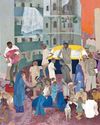
I read this line over and over, wondering what Fenn meant—and looking for a clue. He didn’t write, “I never buried the treasure.” He just doesn’t want me to tell anybody else he did. Which means ... what, exactly?
My mind races, and I briefly consider giving up on journalism to become a full-time treasure hunter. That is the power of Forrest Fenn’s treasure, a prize that in the past nine years has lured a surprisingly large and enthusiastic group of treasure hunters.
Fenn and his wife ran a high-end gallery in Santa Fe, New Mexico, and amassed a personal collection that included [the famous Native-American chief ] Sitting Bull’s original peace pipe and a mummified falcon from King Tut’s tomb. In 1988, Fenn was diagnosed with kidney cancer. Faced with his own mortality, he came up with a crazy scheme: He would bury some of his favourite artefacts somewhere in the Rocky Mountains and then die next to them. “My desire was to hide the treasure and let my body stay there and go back to the soil,” he explains.
He beat the cancer and put the treasure idea on hold for two decades, until his 80th birthday, when he decided to finally go through with it (minus the dying in the wilderness part). Fenn filled an antique bronze lockbox measuring 10 inches by 10 inches with hundreds of treasures: gold coins and nuggets, rubies, diamonds, emeralds, Chinese jade carvings and pre-Columbian gold bracelets. The contents are worth somewhere between $1 million and $5 million, based on estimates Fenn has given over the years. Then he took his treasure chest out into the Rockies and hid it.
This story is from the {{IssueName}} edition of {{MagazineName}}.
Start your 7-day Magzter GOLD free trial to access thousands of curated premium stories, and 9,000+ magazines and newspapers.
Already a subscriber ? Sign In
This story is from the {{IssueName}} edition of {{MagazineName}}.
Start your 7-day Magzter GOLD free trial to access thousands of curated premium stories, and 9,000+ magazines and newspapers.
Already a subscriber? Sign In

BOOKS
Books review

STUDIO - Off Lamington Road by Gieve Patel
Oil on Canvas, 54 x 88 in

NEWS FROM THE WORLD OF MEDICINE
FOODS THAT FIGHT DEMENTIA

TO HELL AND BACK
The Darvaza crater in Turkmenistan is known as the Gates of Hell. I stood on its edge - and lived to tell the tale

THE SNAKE CHARMERS
Invasive Burmese pythons are squeezing the life out of Florida's vast Everglades. An unlikely sisterhood is taking them on

Sisterhood to Last a Lifetime
These college pals teach a master class in how to maintain a friendship for 50-plus years

...TO DIE ON A HOCKEY RINK
ONE MINUTE I WAS PLAYING IN MY BEER LEAGUE, THE NEXT I WAS IN THE HOSPITAL

Just Sit Tight
Broken, battered and trapped in a ravine for days, I desperate driver wonders, \"Will anyone find me?\"

Allow Me to Mansplain...
If there's one thing we know, it's this: We're a nation of know-it-alls

THE BITTER TRUTH ABOUT SUGAR (AND SUGAR SUBSTITUTES!)
It's no secret that we have a serious addiction. Here's how to cut back on the sweet stuff, once and for all.